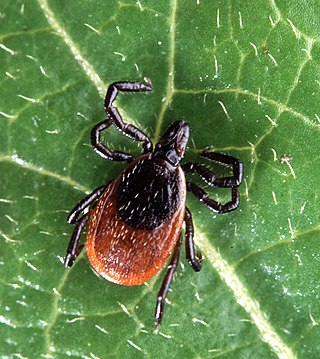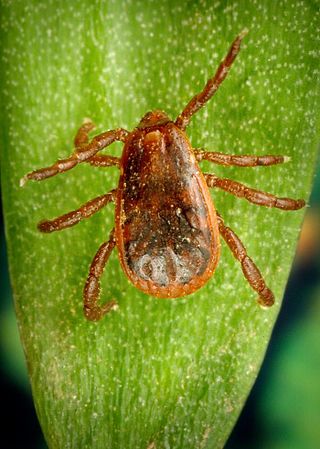
Ticks are parasitic arachnids of the order Ixodida. They are part of the mite superorder Parasitiformes. Adult ticks are approximately 3 to 5 mm in length depending on age, sex, species, and "fullness". Ticks are external parasites, living by feeding on the blood of mammals, birds, and sometimes reptiles and amphibians. The timing of the origin of ticks is uncertain, though the oldest known tick fossils are from the Cretaceous period, around 100 million years old. Ticks are widely distributed around the world, especially in warm, humid climates.

The Ixodidae are the family of hard ticks or scale ticks, one of the three families of ticks, consisting of over 700 species. They are known as 'hard ticks' because they have a scutum or hard shield, which the other major family of ticks, the 'soft ticks' (Argasidae), lack. They are ectoparasites of a wide range of host species, and some are vectors of pathogens that can cause human disease.

The monito del monte, or colocolo opossum, is a diminutive species of marsupial native only to south-western South America. It is the only extant species in the ancient order Microbiotheria, and the sole New World representative of the superorder Australidelphia, being more closely related to Australian marsupials than to other American marsupials. The species is nocturnal and arboreal, and lives in thickets of South American mountain bamboo in the Valdivian temperate forests of the southern Andes, aided by its partially prehensile tail. It consumes an omnivorous diet based on insects and fruit.

Ixodes holocyclus, commonly known as the Australian paralysis tick, is one of about 75 species in the Australian tick fauna and is considered the most medically important. It can cause paralysis by injecting neurotoxins into its host. It is usually found in a 20-kilometre wide band following the eastern coastline of Australia. Within that range, Ixodes holocyclus is the tick most frequently encountered by humans and their pets. Because the same area includes Australia's most densely populated regions, bites on people, pets and livestock are relatively common.

Dermacentor variabilis, also known as the American dog tick or wood tick, is a species of tick that is known to carry bacteria responsible for several diseases in humans, including Rocky Mountain spotted fever and tularemia. It is one of the best-known hard ticks. Diseases are spread when it sucks blood from the host. It may take several days for the host to experience symptoms.

Ixodiphagus hookeri, the tick wasp, is an encyrtid wasp which lays its eggs into ticks. It seems to use a symbiotic bacteria, Wolbachia pipientis, to weaken the tick's immune system.

Ixodes is a genus of hard-bodied ticks. It includes important disease vectors of animals and humans, and some species inject toxins that can cause paralysis. Some ticks in this genus may transmit the pathogenic bacterium Borrelia burgdorferi responsible for causing Lyme disease. Additional organisms that may be transmitted by Ixodes are parasites from the genus Babesia, which cause babesiosis, and bacteria from the related genus Anaplasma, which cause anaplasmosis.

Ixodes scapularis is commonly known as the deer tick or black-legged tick, and in some parts of the US as the bear tick. It was also named Ixodes dammini until it was shown to be the same species in 1993. It is a hard-bodied tick found in the eastern and northern Midwest of the United States as well as in southeastern Canada. It is a vector for several diseases of animals, including humans and is known as the deer tick owing to its habit of parasitizing the white-tailed deer. It is also known to parasitize mice, lizards, migratory birds, etc. especially while the tick is in the larval or nymphal stage.

Ixodes ricinus, the castor bean tick, is a chiefly European species of hard-bodied tick. It may reach a length of 11 mm (0.43 in) when engorged with a blood meal, and can transmit both bacterial and viral pathogens such as the causative agents of Lyme disease and tick-borne encephalitis.

Amblyomma americanum, also known as the lone star tick, the northeastern water tick, or the turkey tick, is a type of tick indigenous to much of the eastern United States and Mexico, that bites painlessly and commonly goes unnoticed, remaining attached to its host for as long as seven days until it is fully engorged with blood. It is a member of the phylum Arthropoda, class Arachnida. The adult lone star tick is sexually dimorphic, named for a silvery-white, star-shaped spot or "lone star" present near the center of the posterior portion of the adult female shield (scutum); adult males conversely have varied white streaks or spots around the margins of their shields.

Rhipicephalus is a genus of ticks in the family Ixodidae, the hard ticks, consisting of about 74 or 75 species. Most are native to tropical Africa.

Ixodes pacificus, the western black-legged tick, is a species of parasitic tick found on the western coast of North America. I. pacificus is a member of the family Ixodidae. It is the principal vector of Lyme disease in that region. I. pacificus larvae and nymphs typically feeds on lizards and small mammals, while adults typically feed on deer. It is an ectoparasite that attaches itself to the outside of its host and feeds on the host's blood. It can have a heteroxenous lifestyle or monoxenous life cycle depending on how many hosts it feeds on in each cycle. I. pacificus has a four stage life cycle that takes around 3 years to complete. These stages include egg, larva, nymph, and adult. They prefer dense woodland habitats or areas of brush and tall grass.

Ixodes hexagonus, also known by the common name hedgehog tick, is a tick species in the genus Ixodes. It is a parasite of the European hedgehog.
Ixodes microgalei is a species of Ixodes that was discovered in the humid eastern forests of the Antananarivo Province in Madagascar. Females of this species parasitize various species of shrew tenrecs of the genus Microgale. All members of the genus Microgale, as well as of the larger subfamily to which that genus belongs, are endemic to Madagascar.

Ixodes angustus is a species of parasitic tick, whose range encompasses the majority of Canada and the United States, along with parts of northern Mexico. I. angustus is a member of the Ixodidae (hard-bodied) family of ticks. It is most abundant in cool, moist biomes such as riparian, boreal or montane zones. I. angustus is a host generalist and has been discovered feeding on more than 90 different host species, including humans and domestic dogs. I. angustus has been identified as a potential vector for Lyme disease but is not considered a principal vector due to the relative rarity with which it feeds on humans.

Ixodes tasmani, colloquially known as the common marsupial tick, is an Australian species of hard-bodied tick. It is a common vector for certain pathogens. There are around 70 species of ticks found in Australia, 16 of which, Ixodes tasmani included, are able to parasitize humans.
Maria Tonelli-Rondelli was an Italian entomologist who studied the taxonomy and identification of ticks (Ixodidae), especially South American species.

Natalia Aleksandrovna Filippova was a world authority on the taxonomy of mites and especially ticks. Her monographs on the identification, morphology, development, distribution and behaviour of the family Argasidae and the sub-families of Ixodinae and Amblyomminae are standard works on these important vectors of disease.
Ixodes anatis, also called the kiwi tick, is a species of tick in the arthropod family Ixodidae. It is endemic to New Zealand and mainly parasitizes kiwi.













